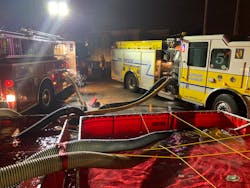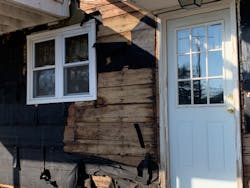Fire Studies: Suppression & Survivability in the Rural Environment
When the term “rural” is heard, most people automatically think of green pastures, rolling hills and farms, a setting that’s far removed from urban landscapes and densely populated cities, a setting that’s reserved for middle America and parts far from organized civilization. However, green pastures, rolling hills and farms can be found clustered within urban and metropolitan cities, producing food, materials, and other consumables that serve the needs of nearby cities and towns.
In some cases, these areas are more susceptible to significant events, such as extreme weather, droughts and, of course, fires. Damage that’s caused by fires can be worse in these areas for two reasons: Fires might burn longer before they are noticed, and distances between communities and residents can result in longer response times for responders. Given limited funding for staffing and large coverage areas for volunteer agencies, these fires can become million-dollar losses, and that, in turn, can affect the communities that rely on the resources that come from these areas.Rural settings
The fire service is responsible for three main priorities when responding to fire emergencies: suppression (in the most simple of terms, putting out the fire quickly and efficiently), survivability (for people to be rescued, the compartment must be survivable) and stabilization (stopping the fire/event from progressing and proactively removing the hazards).
When discussing planning for fire suppression and tactical consideration for the rural interface, considerable differences exist in some of the size-up points compared with those that are pertinent to urban and metropolitan areas. These differences can be game-changers on the fireground, and tactics must be based on the actionable intelligence that influences the three priorities that are noted above.
Construction
The rural landscape once was covered with buildings that were built to withstand the tests of time, nature and the elements. With the advancements in construction technology and materials, responders should expect to find a wide range of construction concepts and materials within their jurisdiction(s)—from buildings that are hundreds of years in age that have multiple vertical and horizontal void spaces, to structures that have newer engineered structural materials, which change the combustibility of the buildings and provide challenges to coordination of operations within the compartment.
Utilities
With limited infrastructure in some rural communities, more residents are becoming self-dependent in terms of obtaining their heating and electricity needs.
Rural areas might have large land masses that can serve as solar electrical generating farms. As a result, residents might have large amounts of solar panels within and mounted on their property.
Large, pressurized tanks of flammable gases can provide cooking and heating fuels to buildings. These can become significant exposure issues as well as large flammable and explosive hazards during the fire.Setback properties
Large acreage can serve as a setting for multiple buildings of varying size and use. With these structures spread out within the property lines, accessibility and placement is challenging at best. Gaining access that affords a clear path for the attack engine and stable ground for the aerial or tower ladder to set up takes planning.
Availability of water
Limited infrastructure coupled with larger commercial-size buildings that have heavier fuel loads and that can be far from the roadway require a larger initial response of resources that are dedicated to making sure that the needed fire flow is available. These resources should be mobilized on the initial alarm to reduce turnout time and to increase response capabilities.Furthermore, preplanning of dry hydrants and static water sources that can be utilized for fire suppression—as well as access plans by which to utilize them—should be completed.
Rural strategy & tactics
Although multiple considerations must be made during initial size-up, certain factors require specific attention. One should know that these points can be vastly different than within a size-up in an urban environment, and the incident commander must make sure that these needs are met.
Accessibility. On arrival to the address, a considerable “stretch” might be required to make it to the building that’s on fire. The first-due (and second-due) apparatus might need to continue into the property to position near the burning building to effectively deploy resources and equipment into operation.
It also is critical to consider alternate means of access within the property that will lead to the scene. (For example, consider how difficult, if not impossible, it will be for additional resources to make it up to the scene if the large-diameter supply line is dropped in the middle of the only access road to the fire building.) Identify secondary access points and announce them to all responding resources.Compartment properties. Having a competent preplan program is paramount for all aspects of the incident, and the materials that make up the construction of the structure are a vital point.
Metal roofs hamper vertical ventilation, which causes delays in coordinated operations.
Older Type V buildings might have larger structural timbers, but their lack of moisture content speeds up combustion and leads to faster structural failure.
Larger buildings might contain fuel-powered vehicles. This factor can add to the heat release rate of the fire load within the compartment exponentially.
Sustained water supply. Needed fire flow calculations might require larger streams for initial operations, depending on conditions that are found on arrival.
Moving water up to the scene requires large relay operations and, possibly, tender operations. Tender operations include a sufficient-size dump site for water delivery and an efficient route of travel for these vehicles to access the scene, drop their payload, get refilled and return to the scene. The number of supply vehicles that are needed is predicated on the amount of water that each vehicle can transport and how fast the water is utilized during firefighting operations.
Survivability
One major consideration decides whether there is a rescue or recovery to be made: The compartment where the potential victim is located must be survivable. Actions that are taken by the initial-arriving companies must operate to make the space survivable. These actions require personnel, equipment and resources for coordinated operations to be effective. A response plan should include enough of each on the initial dispatch to provide the best chances for the victim.Suppression
The initial resources play a critical role in the overall success of the incident. Resources that arrive quickly with ample supply of water, tools and personnel that go right to work can lead to great success. Onboard water can be 750–1,000 gallons or more on some first-due apparatus. Having that much extinguishing capability on arrival is undoubtely a significant advantage to the succes of the overall operation.
Strategic considerations
Consider this scenario: You arrive at a structure fire. The structure is a two-story, 3,500-square-foot, Type V residential occupancy. It has a pitched metal roof and is assumed occupied. There is smoke throughout the structure.
Most readers likely envisioned a structure that’s located in an urban setting.
Now, add the rural caveats that might hamper decision-making: Structures in this area are roughly 100 years old; they are completely surrounded by trees; there are no hydrants; the driveway up to the structure is 400 feet long, 10 feet wide and made of gravel; and a 500-lb. pressurized gas tank that supplies fuel for cooking and heat on the property is roughly 50 feet from the building. Now what?As always, your priorities on arrival are suppression, survivability and stabilization. What actions do the initial companies take to meet the priorities of the incident? More information is needed: How much water is on scene? What is the air track for the fire? What is the best access for suppression?
Perform the 360-degree size-up with the thermal imager. By doing this, you can identify clues as to where the fire is and where it’s going. Once identified, control the air track to limit spread and to provide the best access for any victims.
Next, identify the best application of water for the most efficient use of on-scene water. Your water supply takes time to set up, and the best use of the water that’s available immediately is in the application that will be beneficial for both suppression and survivability. Now, this might mean that the first engine doesn’t commit until this information is determined. It might take an extra 30 seconds to opt for the best location of the apparatus, and pulling an attack line prematurely without consideration for the attack plan causes delays, which allows the combustion process to grow possibly beyond the capabilities of the first-alarm resources.
Prep for success
Departments that are fortunate enough to have ample hydrants within their jurisdiction, limited setbacks from the street and commonplace utility control capabilities might struggle when the rules of engagement are changed to a more rural setting. For those who respond in these areas regularly, having initial responding resources with efficiency that’s built into equipment, policies and tactical operations leads to great success.
Michael Daley will present “Fireground Strategies: Size-Up for Suppression and Survivability” at Firehouse Expo. To register, visit firehouseexpo.com.
About the Author

Michael Daley
MICHAEL DALEY, who is a Firehouse contributing editor, recently retired as a 37-year veteran who served as a captain and department training officer in Monroe Township, NJ. He is a staff instructor at multiple New Jersey fire academies and is an adjunct professor in the Fire Science Program at Middlesex County College. Daley is a nationally known instructor who has presented at multiple conferences, including Firehouse Expo and Firehouse World. His education includes accreditations as a Chief Training Officer and a Fire Investigator, and he completed the Craftsman Level of education with Project Kill the Flashover. Daley is a member of the Institution of Fire Engineers and a FEMA Instructor and Rescue Officer with NJ Urban Search and Rescue Task Force 1. He operates Fire Service Performance Concepts, which is a training and research firm that delivers and develops training courses in many fire service competencies.






